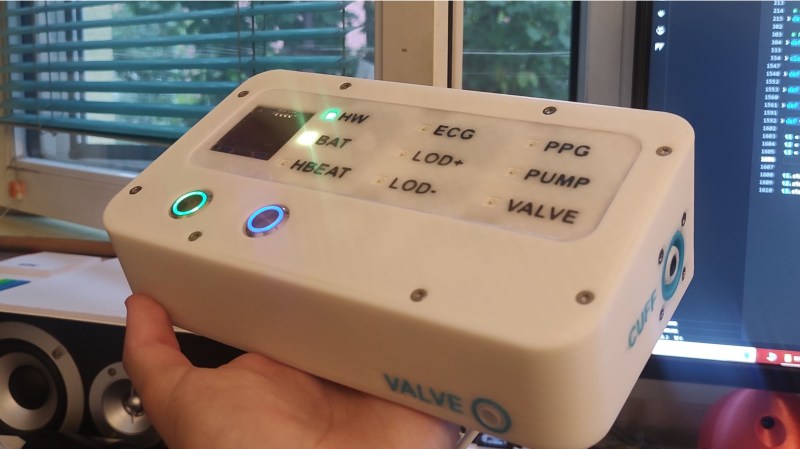Much of the world’s medical equipment is made by a handful of monopolistic megacorps, but [Milos Rasic] built an open cardiography signal measuring device for his master’s thesis.
Using a Pi Pico W for the brains, [Rasic]’s device can record, store and analyze the data from an arm cuff, stethoscope, electrocardiograph (ECG), and pulse oximeter. This data can be used for monitoring blood pressure in patients and he has results from some of his experiments to determine the optimal algorithm for the task on the GitHub if you really want to get into the nitty gritty details.
Inside the brick-sized enclosure is the custom PCB, an 18650 Li-ion cell, and a pneumatic assembly for the arm cuff. Medical sensors attach via GX12 connectors on the back, a USB type B connector is used for data, and a USB C connector provides power for the device. The brightly colored labels will no doubt come in handy in a clinical setting where you really want to be sure you’ve got everything plugged in correctly.
Want more open medical equipment? How about an open ECG or this less accurate, but more portable, credit card ECG? We’d be remiss not to mention the huge amount of work on ventilators during the worst days of the COVID-19 pandemic as well.
















This could be great for non-US use. In the US at least, the tech isn’t expensive because the tech is cutting edge, it is the approval and testing and certification that cost mega bux to get a device to market for use in humans.
In my developing nations work, we bought knock-off monitors and they are pretty janky, and enough of them flat don’t work at all enough that the results of the “working” ones is pretty suspect. We don’t do that anymore.
Complex topic but good to see (hopefully) affordable and reliable (the results matter! a lot!) as well. Nice.
I suspect that liability insurance is a non-trivial part of the cost in the US.
Just think of how many dreams would come true if we weren’t so sue happy.
How much premium you want to pay for guaranteed correct results and fail-safe behaviour is a very valid question in healthcare equipment
The most interesting part of a hack like this is the opamps used, no?
Check out the AD5940. All the analog stuff you could want for bio application in one chip, felt like an analog FPGA when I was working with it. Only thing is it doesn’t do PPG/photodiode stuff …natively.
I did a quick scroll through the various links in this project. The electronics are all there but just a picture of the pneumatics.
Are details of that there and I just missed them?
My doctor flatly refuses to look at rhythm strips from my Arduino based ECG machine because it’s not FDA approved. But in discussions he will accept my interpretation of them.
That’s kinda funny honestly
Because if he made any sort of comment/diagnosis based upon your strips, and it turned out they were completely inaccurate, he would still be liable.
It’s all about plausible deniability.
So, you are diagnosing yourself, are you? H’mmm